
Stone walkways are a timeless addition to any garden, offering both functionality and aesthetic appeal. They guide visitors through your outdoor space while adding texture, color, and character to your landscape. Whether you’re looking to create a formal path or a rustic trail, there’s a stone walkway design to suit every garden style. In this article, we’ll explore 27 of the best stone walkway design ideas to inspire your next landscaping project.
1. Natural flagstone path
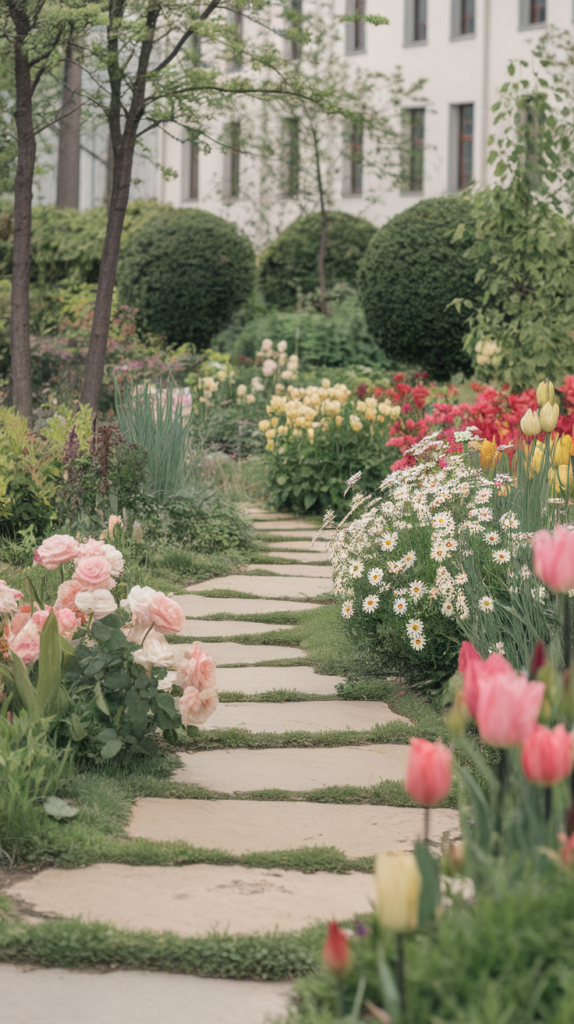
A natural flagstone path offers a classic and elegant look for any garden. These large, flat stones come in various shapes and colors, allowing for a unique and organic design. Lay the stones in a random pattern for a more natural appearance, or create a more structured layout for a formal look.
The spaces between the stones can be filled with small pebbles, gravel, or even ground cover plants for added interest. This type of walkway blends seamlessly with various garden styles, from cottage gardens to modern landscapes. For more ideas on incorporating stone into your outdoor space, check out our article on stone designs transform your front yard.
2. Stepping stone trail

Stepping stone walkway ideas offer a whimsical and practical solution for garden paths. These individual stones can be placed at comfortable stepping distances, allowing grass or ground cover to grow between them. This design creates a more natural, less formal look that’s perfect for cottage gardens or woodland-inspired landscapes.
Choose from circular, square, or irregularly shaped stones to suit your garden’s style. You can even create your own custom-shaped stepping stones for a truly unique path. For more inspiration on creating charming garden paths, take a look at our guide on farmhouse landscaping ideas.
3. Mosaic stone pattern
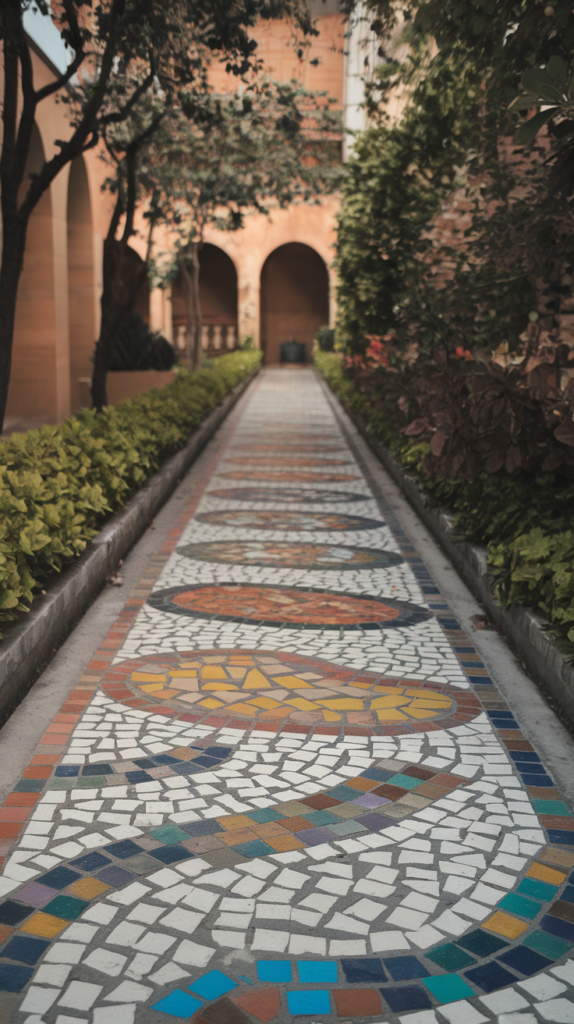
For those looking to add a touch of artistry to their garden, a mosaic stone walkway is an excellent choice. This design uses smaller stones or tiles to create intricate patterns or images along the path. You can opt for geometric designs, floral motifs, or even create a personalized design that reflects your interests or the theme of your garden.
While more time-consuming to install, a mosaic stone walkway becomes a stunning focal point in any garden. It’s particularly well-suited to Mediterranean or bohemian-style gardens. For more ideas on incorporating artistic elements into your outdoor space, check out our article on patio into an artistic abode.
4. Cobblestone path

Cobblestone walkways evoke a sense of old-world charm and durability. These small, rounded stones can be arranged in various patterns, from simple rows to more complex designs like herringbone or fan patterns. The uneven surface of cobblestones adds texture and character to your garden.
While traditional cobblestones can be challenging to walk on, modern versions often have flatter tops for increased comfort and safety. This type of walkway pairs well with cottage gardens, Tudor-style homes, or any landscape aiming for a historic feel. For more ideas on creating charming outdoor spaces, take a look at our guide on vintage inspired patios.
5. River rock pathway
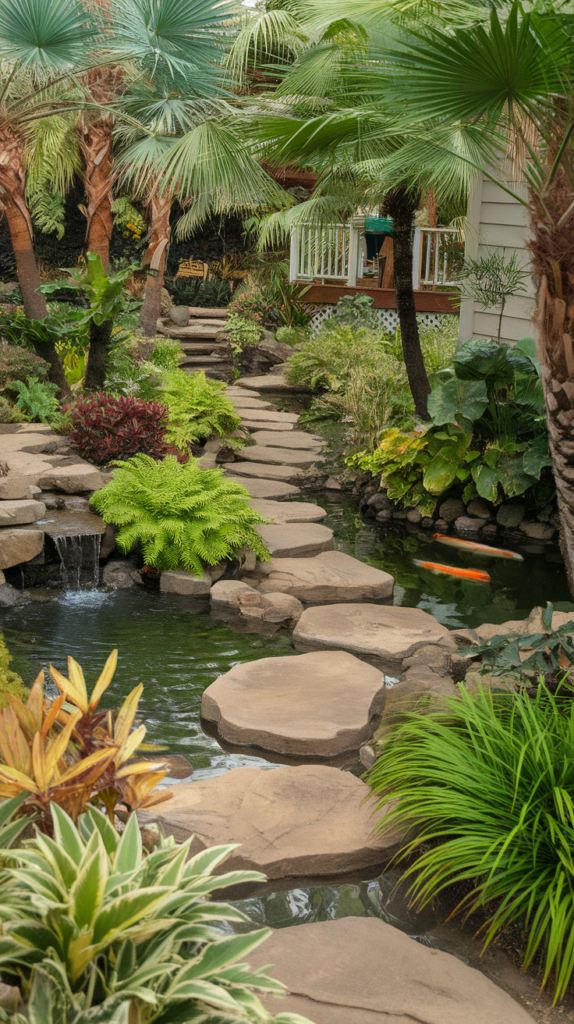
A river rock pathway brings a natural, calming element to your garden design. These smooth, rounded stones come in various sizes and colors, allowing for creative arrangements. You can create a dry creek bed effect by using different sizes of river rocks, with larger stones along the edges and smaller ones in the center.
This type of stone walkway design works particularly well in Japanese-inspired gardens or naturalistic landscapes. The smooth surface of river rocks can be slippery when wet, so consider using a stabilizing material or embedding the rocks in concrete for safety. For more ideas on creating zen-like outdoor spaces, check out our article on how to design a zen garden.
6. Geometric paver design

For a more modern and structured look, consider a geometric paver design for your stone walkway. This approach uses uniform, shaped stones laid in a repeating pattern. Squares, rectangles, and hexagons are popular choices, but you can also find more unique shapes like octagons or triangles.
The clean lines and regular patterns of geometric pavers complement contemporary home designs and minimalist gardens. You can add interest by using contrasting colors or incorporating small planted areas within the pattern. For more inspiration on modern outdoor designs, take a look at our guide on design inspiration for modern patios.
7. Mixed material walkway
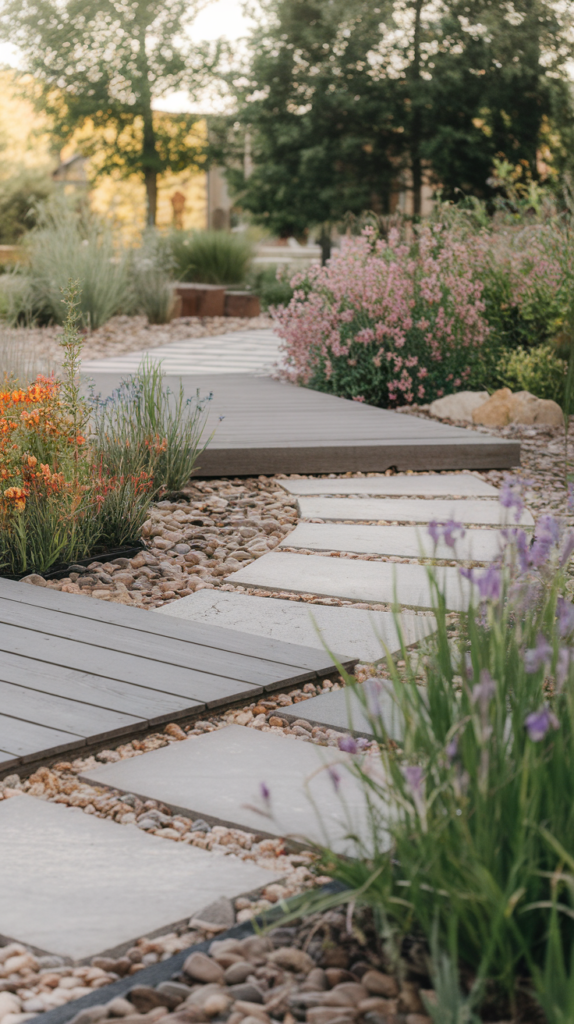
Combining different materials in your walkway design can create a unique and visually interesting path. Consider mixing stone with other materials like brick, wood, or even metal for a truly distinctive look. For example, you could use large stone slabs as stepping stones and fill the spaces between with brick or wooden planks.
This approach allows you to play with textures and colors, creating a walkway that’s truly one-of-a-kind. It’s also a great way to tie together different elements of your landscape design. For more ideas on mixing materials in outdoor spaces, check out our article on concrete patio and wood deck.
8. Crushed stone path
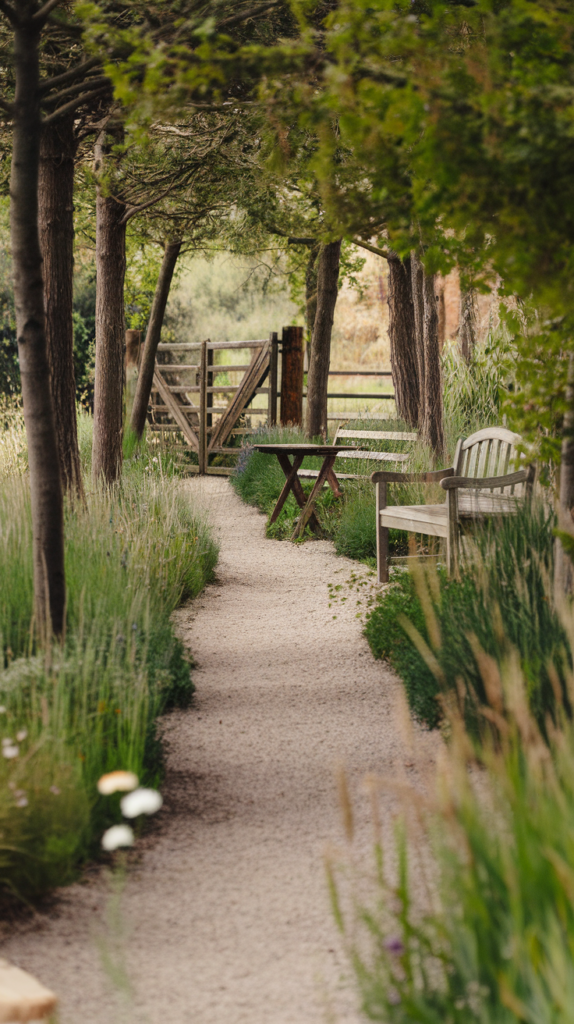
A crushed stone path offers a more casual and affordable option for garden walkways. This material, which consists of small, angular stones, comes in various colors and sizes. It provides good drainage and a natural look that works well in informal garden settings of this 27 easy and cheap walkway ideas.
To create a defined edge for your crushed stone path, consider using larger stones, bricks, or metal edging. This not only keeps the crushed stone in place but also adds a finished look to your walkway. For more ideas on creating budget-friendly outdoor spaces, take a look at our guide on eco-friendly sustainable green patios.
9. Stone and grass combination

For a unique and eco-friendly approach, consider alternating stone pavers with strips of grass or low-growing ground cover. This design creates an interesting visual pattern while allowing for better water absorption and reducing runoff. It’s an excellent choice for those looking to maintain a more natural look in their garden.
Choose stones that complement your home’s exterior and pair them with a hardy grass variety or ground cover that can withstand foot traffic. This design works particularly well in modern or minimalist garden settings. For more ideas on incorporating greenery into your hardscaping, check out our article on plants for contemporary landscape.
10. Spiral stone path

A spiral stone path adds a whimsical and artistic touch to your garden. This design typically starts with larger stones at the outer edge, gradually decreasing in size as they spiral inward. The result is a visually striking walkway that can serve as a focal point in your garden.
Spiral paths work well in circular garden designs or as an interesting approach to a central feature like a fountain or sculpture. They can be created using various types of stone, from uniformly cut pavers to natural, irregular stones. For more unique garden path ideas, take a look at our guide on stair stepped gardens.
11. Stone slab walkway
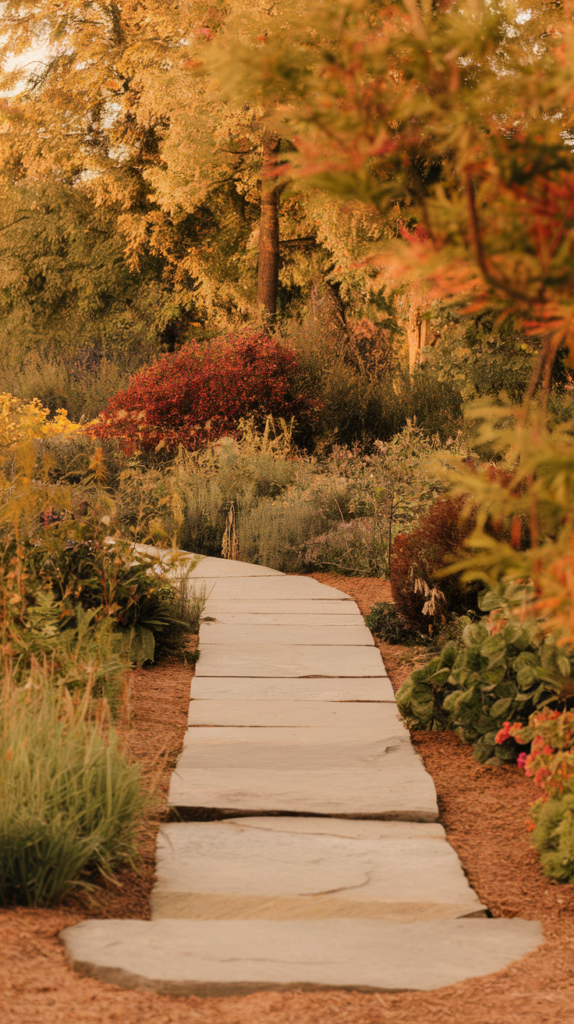
For a bold and contemporary look, consider using large stone slabs for your walkway. These oversized pavers create a strong visual impact and provide a smooth, easy-to-navigate surface. Choose slabs with interesting textures or patterns for added visual interest.
This type of walkway works particularly well in modern garden designs or as a striking contrast in more naturalistic settings. The spaces between the slabs can be filled with gravel, planted with ground cover, or left open for a more minimalist look. For more ideas on creating impactful garden features, check out our article on stone designs transform your front yard.
12. Rustic fieldstone path
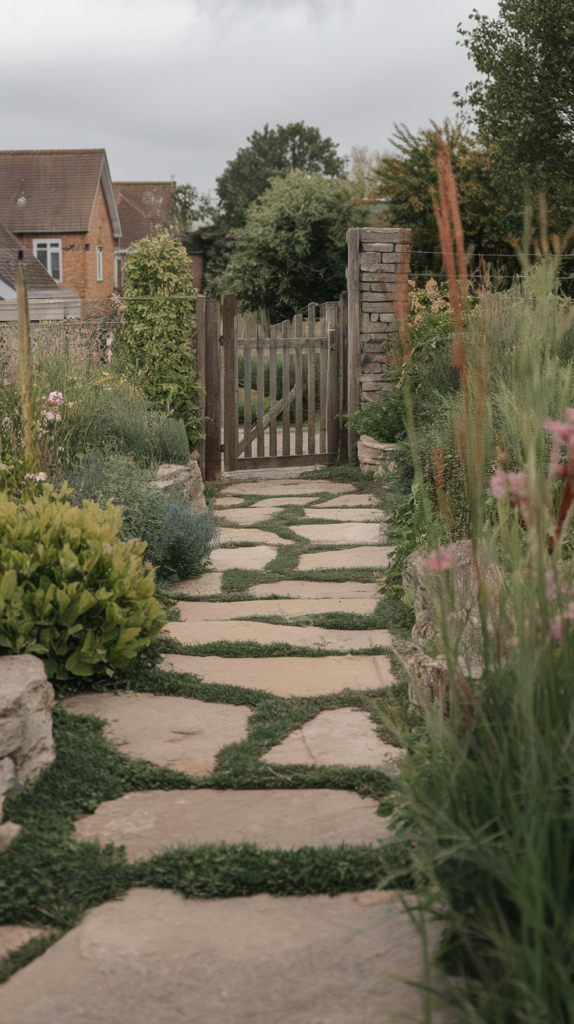
A rustic fieldstone path brings a touch of countryside charm to any garden. These irregularly shaped stones, often sourced locally, create a natural and organic-looking walkway. The varied shapes and sizes of fieldstones result in a unique, one-of-a-kind path that blends beautifully with informal garden styles.
When laying a fieldstone path, take time to fit the stones together like a puzzle, filling smaller gaps with pebbles or plants. This type of walkway pairs well with cottage gardens, woodland landscapes, or any design that aims for a natural, unstructured look. For more ideas on creating charming outdoor spaces, take a look at our guide on farmhouse landscaping ideas.
13. Stone and wood combination
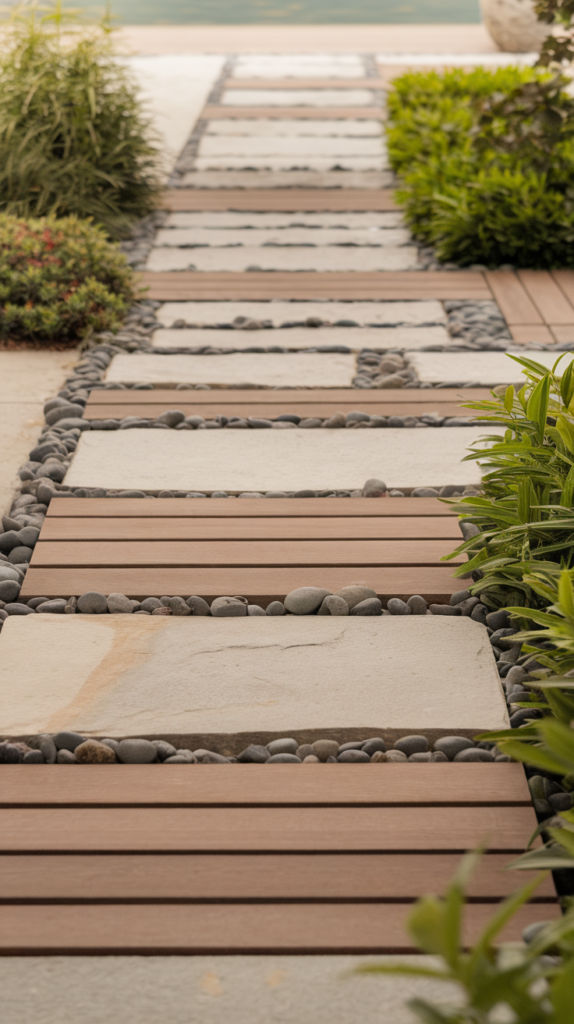
Combining stone with wood creates a walkway that bridges the gap between natural and man-made materials. This could involve alternating stone pavers with wooden planks, or using wood to frame a stone path. The contrast between the two materials adds visual interest and texture to your garden design.
This combination works particularly well in transitional spaces, such as paths leading from a wooden deck to a stone patio. It’s also a great way to tie together different elements in your landscape. For more ideas on mixing materials in your outdoor space, check out our article on concrete patio and wood deck.
14. Embedded pebble mosaic

For a truly unique and artistic walkway, consider creating a pebble mosaic. This involves embedding small, smooth pebbles into a concrete base to create patterns or images. The possibilities are endless – from simple geometric designs to elaborate pictorial scenes.
While labor-intensive, a pebble mosaic walkway becomes a stunning focal point in any garden. It’s particularly well-suited to Mediterranean-style gardens or as an artistic feature in contemporary landscapes. For more ideas on incorporating artistic elements into your outdoor space, take a look at our guide on patio into an artistic abode.
15. Travertine tile path
Travertine, a type of limestone, offers a luxurious option for garden walkways. Its natural variations in color and texture create interest, while its light color helps to brighten garden spaces. Travertine tiles can be laid in various patterns, from a simple running bond to more complex designs like herringbone.
This material is not only beautiful but also durable and slip-resistant, making it an excellent choice for pool areas or regions with frequent rain. For more ideas on using high-end materials in your outdoor space, check out our article on design a mediterranean outdoor.
16. Stone and gravel combination
Combining larger stones with gravel creates a walkway that’s both visually interesting and practical. Large stepping stones or pavers can be set in a bed of gravel, providing solid footing while the gravel fills in the gaps. This design offers excellent drainage and can be easily adjusted or repaired as needed.
Choose complementary colors for your stones and gravel to create a cohesive look. This type of walkway works well in both formal and informal garden settings. For more ideas on using gravel in your landscape design, take a look at our guide on enhance gravel fire pit.
17. Natural stone edged path
Create a defined and polished look for your walkway by using natural stone edging. This involves lining the sides of your path with larger stones or cut stone pieces. The edging not only keeps your path material in place but also adds a finished look to your garden design.
You can use contrasting colors or textures for your edging to make it stand out, or choose materials that blend seamlessly with your path for a more subtle effect. For more ideas on using stone in your landscape design, check out our article on stone designs transform your front yard.
18. Circular stone pattern
A circular stone pattern adds a unique and eye-catching element to your garden walkway. This design typically involves arranging stones in concentric circles, creating a focal point in your landscape. It can be used for an entire path or as an accent feature within a larger walkway design.
Circular patterns work well as gathering spaces in the garden or as transitions between different areas of your landscape. For more ideas on creating interesting patterns in your outdoor space, take a look at our guide on paver patio ideas.
19. Stone and brick combination
Combining stone with brick in your walkway design offers a blend of textures and colors that can complement a variety of home styles. You might use stone as the primary material with brick accents, or vice versa. This combination works particularly well for creating borders, patterns, or transitions in your path.
The warmth of brick pairs beautifully with the cool tones of many stones, creating a balanced and visually interesting walkway. For more ideas on mixing materials in your landscape design, check out our article on brick patio ideas outdoor living.
20. Stone pathway with built-in lighting
Incorporate lighting into your stone walkway for both safety and ambiance. This could involve using LED strip lights along the edges of your path, installing recessed lights between stones, or using illuminated pavers. Lighting not only makes your path safer to navigate at night but also creates a magical atmosphere in your garden after dark.
Choose warm-toned lights for a cozy feel, or cool white lights for a more modern look. For more ideas on outdoor lighting, take a look at our guide on lighting tips for outdoor spaces.
21. Winding stone path
A winding stone path adds a sense of mystery and adventure to your garden. Instead of a straight line from point A to point B, create curves and turns that invite exploration. This design works particularly well in larger gardens or those with varied topography.
Use the curves of your path to highlight different garden features or create distinct “rooms” within your landscape. For more ideas on creating interesting garden layouts, check out our article on l shaped backyard ideas.
22. Stone path with water feature
Combine your stone walkway with a water feature for a truly immersive garden experience. This could involve creating a small stream that runs alongside or under your path, or incorporating a fountain or pond into your walkway design. The sound of water adds a soothing element to your garden and can help mask unwanted noise.
Ensure proper drainage and waterproofing when combining stone and water features. For more ideas on incorporating water into your landscape design, take a look at our guide on water features, vertical gardens, retaining walls.
23. Terraced stone walkway
If your garden has a slope, consider creating a terraced stone walkway. This involves building a series of flat stone paths connected by short flights of stairs or gentle inclines. Not only does this make navigating a steep garden easier, but it also adds visual interest and can create distinct garden “rooms”.
Use retaining walls between terraces to prevent soil erosion and create additional planting spaces. For more ideas on managing sloped landscapes, check out our article on backyard hill ideas.
24. Stone labyrinth path
For a truly unique and meditative garden feature, consider creating a stone labyrinth path. Unlike a maze, a labyrinth has only one path that leads to the center and back out. Walking a labyrinth can be a calming and contemplative experience.
Create your labyrinth using different colored stones or by embedding stones in grass or gravel. For more ideas on creating zen-like garden spaces, take a look at our guide on how to design a zen garden.
25. Stone and metal combination
For a modern and industrial look, consider combining stone with metal elements in your walkway design. This could involve using metal edging, incorporating metal grates or bridges into your stone path, or using metal inlays between stone pavers.
The contrast between the natural texture of stone and the sleek look of metal creates a striking visual effect. For more ideas on creating contemporary outdoor spaces, check out our article on design inspiration for modern patios.
26. Eco-friendly permeable stone path
Consider a permeable stone path for an environmentally friendly option. This type of walkway allows water to seep through into the ground, reducing runoff and helping to recharge groundwater. It typically involves laying stones with wider gaps and filling these gaps with materials like gravel or special permeable joint fillers.
Permeable paths are particularly useful in areas prone to flooding or where water conservation is a priority. For more eco-friendly landscaping ideas, take a look at our guide on eco-friendly sustainable green patios.
27. Stone pathway with vertical elements
Add interest to your stone walkway by incorporating vertical elements. This could involve lining your path with tall grasses, installing archways or pergolas over sections of the path, or using upright stones or sculptures as accents. Vertical elements add depth and dimension to your garden design.



